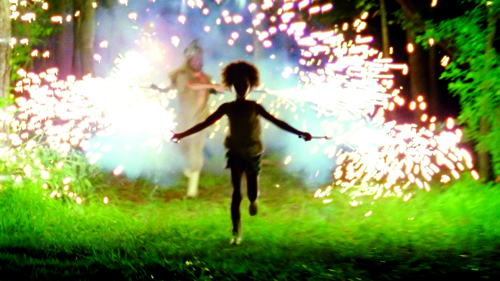First-time actors debut in Benh Zeitlin’s New Orleans scrapbook Beasts of the Southern Wild—a lucky find
Leslie Armstrong
Editor-in-Chief

as Hushpuppy in Beasts of the Southern Wild. – Courtesy of TIFF
Following the story of a six-year-old girl learning to survive on her own as her father is dying of an unknown illness, Beasts of the Southern Wild exalts in Louisiana imagery. When the father passes away, the main heroine will have to bear the ravages of the land, her home.
It’s a wonder that the two lead roles, Hushpuppy (Quvenzhané Wallis) and Wink (Dwight Henry), were played by people with zero acting experience. My soft spot for Benh Zeitlin’s award-winning directorial debut is rooted in these two stunning performances.
Wallis, a fiery eight-year-old girl, is the same person on-screen as she is off-screen. On-screen, she gives us her signature scowl after she snaps the body of a crab with her bare hands to chants of “Beast it! Beast it!” Off-screen, she sits with director Zeitlin and points to a part in the narratorial script, telling him to scrap it. After all, she will be narrating the entire film, and wants to sound like herself.
Henry, who auditioned for the part of Wink when a casting call was posted at the bakery he owned and worked, returned to the restaurant industry after his role in Beasts.
In terms of the elements of storytelling used in the film, the focus is mainly aesthetic, relishing in authentic imagery of a lifestyle.
The quirky resourcefulness of the people from “The Bathtub,” a fictional island within New Orleans at risk of going under water any moment, comes through in snippets.
The islanders lodge a hidden bomb in the mouth of a dead crocodile’s mouth and drag it along offshore to bust the levee, which is causing the flood on their land.
The details come from a cast that has experienced floods first-hand.
Henry, who plays Wink, experienced both Hurricane Betsy in 1965 and Hurricane Katrina in 2005.
Tough love makes up a large part of the film’s underlying themes. Hushpuppy learns independence and resourcefulness from her seemingly violent, insensitive father Wink, who often throws slurs and insults at her, and becomes impatient when she makes mistakes.
But a reassuring display of parental love pervades the film. When Hushpuppy flees her father and runs out to the middle of the field, Wink goes out to collect her, picking her up by the seat of her pants, the way a mother lion picks her young up by the scruff of the neck.
However, the high aesthetic focus is such that the other elements of storytelling, like plot and script, are somewhat weak.
Amidst the symbolism of the wild boars and the heavy focus on a rich, organic picture, the plot left me, at times, confused. I couldn’t tell the difference between Hushpuppy’s wild imagination and her waking life.
At times, the script was ill-fitted to Hushpuppy, the most dialogue-heavy role in the film. Allowing Wallis to have an active voice in the script was Zeitlin’s saving grace, but the authenticity of a six-year-old’s lingo was not always present, with Hushpuppy, in some instances, sounding too adult-like, and Wallis’s acting could not always save the script.
But these flaws are inconsequential in the face of a strong running theme: the importance of home. When social workers come to rescue the people of the Bathtub from the flood, they escape the hospital and find their way back to their flooded, destroyed homes.
Hushpuppy chooses to learn survival, without a mother or father, and pardons the fickle quality of the land. She begins and ends the film by saying: “Once, there was a Hushpuppy, and she lived with her Daddy in the Bathtub.”


